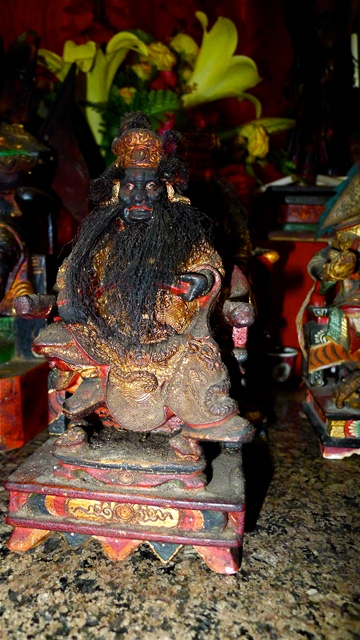The Legend Behind a Chinese Boat Burning Ceremony in Penang

Ronni Pinsler attends a night time boat burning ceremony in a Taiping temple and delves into the Chinese legend that underpins this ancient ritual.
One of the things that I love about living in Malaysia is the diversity and vibrancy of the culture. I believe it’s fairly rare that a modern developing country still has such an intensity of folk religion and respect for past traditions. Some customs even survive here that are no long practiced in their native countries of India and China. I recently attended a boat burning festival in Taiping that is based on a 2,000-year-old Chinese legend.
The Wang Ye Temple in Taiping Just a couple of hours’ drive from Penang, and not that much more from KL, is the heritage city of Taiping. It’s worth a visit in any case for the old roads of as yet unrestored shophouses, some magnificent Edwardian era colonial buildings, and, of course, the famous lake gardens and zoo. Taiping was founded as a tin town and the Chinese miners who came here in the mid-19th century brought their Taoist deities with them along with their complex mythologies. One of the stories concerns Wang Ye, a deity associated with pestilence and plague prevention. There are about a thousand temples devoted to Wang Ye in Malaysia, and the one in Taiping is worth visiting, especially in May for the annual festival which celebrates Lee Wang Ye’s birthday. The centre piece of the celebration is the burning of a large papier mâché and plywood boat. It’s more than 15 feet long, so it’s mounted on a trolley for ease of movement. It actually mirrors the boat sculpture that you can find in all Wang Ye temples. You can identify them by the presence of a model wooden boat outfitted with sailors, sails, navigational equipment, liquor bottles, and musical instruments. These temple boats are generally smaller and made of wood and more durable materials.
The Wang Ye Legend

The legend behind the celebration is interesting. During the Eastern Han Dynasty (25-300 CE) there lived the most famous of Chinese Magicians – Chang Tao Ling, who was exceptionally good at dealing with spirits who spread plagues. The Emperor of the time wished to test Chang’s abilities. Some of his envious ministers accused the magician of being a charlatan. So he arranged for his personal orchestra of over 300 musicians to be removed to the palace basement and he ordered them to play music.
Then the Emperor told Chang that the palace was infested with malignant entities who were making uncontrollable noises. The musicians playing could be heard as a humming in the palace reception hall. “Do you wish me to destroy them?” asked Chang. When the Emperor affirmed that he did, Chang replied that he would not be responsible for the consequences. Using hand gestures combined with the incantation of arcane spells, Chang performed his magic and silenced the offending sounds. The royal party next went to the basement to find all the musicians lying on the floor, dead. Now, this turned out to be the beginning of a new problem for the Emperor, because he had murdered 300 innocents. The spirits of the dead musicians started haunting the palace, particularly at night, preventing the Emperor from sleeping.
Fed up with insomnia, the Emperor – on advice from his minister – decided to award titles of Wang Yeh (which means King) to each victim. He distinguished each one of these “kings” with a different Chinese family name, so creating a group of around 300 of the most common surnames in the country. These posthumous titles therefore had names like Lim Wang Yeh, Tan Wang Yeh, Cheah Wang Yeh, etc. Most of these musicians turned deities were patrons of disease and plagues, for example smallpox, yellow fever, leprosy, and so on. For their birthday celebrations, a small boat would be built and filled with food and liquor as well as musical instruments for entertainment. The boats would then set off unpiloted either towards open sea or along a river. Driven by the vagaries of wind and tide, the boat would finally reach land, the nearest village would have to entertain the visiting plague god with lavish banquets, theatrical entertainments in exactly the same manner as if a living high government official was visiting. After approximately three days, the boat would be cast off to continue its journey until the next landfall. It was believed that entertaining the Pestilence deity during his visit would prevent the arrival of actual plagues and sickness.
During the 2003 SARS epidemic, several Wang Yeh related temples held large processions in different cities in Malaysia. Most notably, was a massive Boat Burning procession, or Wakang, which hadn’t been performed since 1933 and which shut down the entire traffic system in the centre of Melaka for a day.
The Festival Celebration
It’s believed that Wang Yeh himself actually presides over his birthday celebration and is present in trance form possessing the temple medium. It’s considered good form to invite other Deities to attend the party.
The festival procession proceeds from the temple in Taiping to the local river, about one kilometre away. It’s actually more of a stream in actual fact but it is at least it is flowing water. The boat is set along the bank. Gold paper and hundreds of pieces of joss are placed along the base. Libations of food and wine are made. So as to ensure a good fire, the old altar cloths, lanterns, and other items from the temple as well as other combustible items are carefully placed at the base of the boat. The temple chairman lights a candle and begins the conflagration. It is spectacular as the fire quickly spreads through the paper and wooden frame. A group of devotees circle the boat once and then leave the scene without glancing back. According to tradition, it is extremely unlucky to look back once you have gone.
The mediums, who are still in trance, and the devotees then head back to the temple. Lee Wang Yeh of Taping has had a wonderful and successful send off and it to be hoped that sickness and disease will mostly kept at bay from the village for the coming year. To me it seems that the Malaysian attitude of royally entertaining all visitors regardless of whether they are ethereal or living is part and parcel of the generous spirit of the country.
Homepage Highlight Photo credit: Sandro_Lacarbona / Foter / Creative Commons Attribution-NonCommercial-NoDerivs 2.0 Generic (CC BY-NC-ND 2.0)
Source: The Expat Magazine July 2014
Read more:
- 3 Museums on Penang’s Armenian Street You Should Visit
- 11 Reasons Why Mosquitoes Bite Some People More Than Others
- Get to Know Malaysia’s Wayang Kulit (Shadow Puppet)
What are your thoughts on this article? Let us know by commenting below.No registration needed.
"ExpatGo welcomes and encourages comments, input, and divergent opinions. However, we kindly request that you use suitable language in your comments, and refrain from any sort of personal attack, hate speech, or disparaging rhetoric. Comments not in line with this are subject to removal from the site. "


















